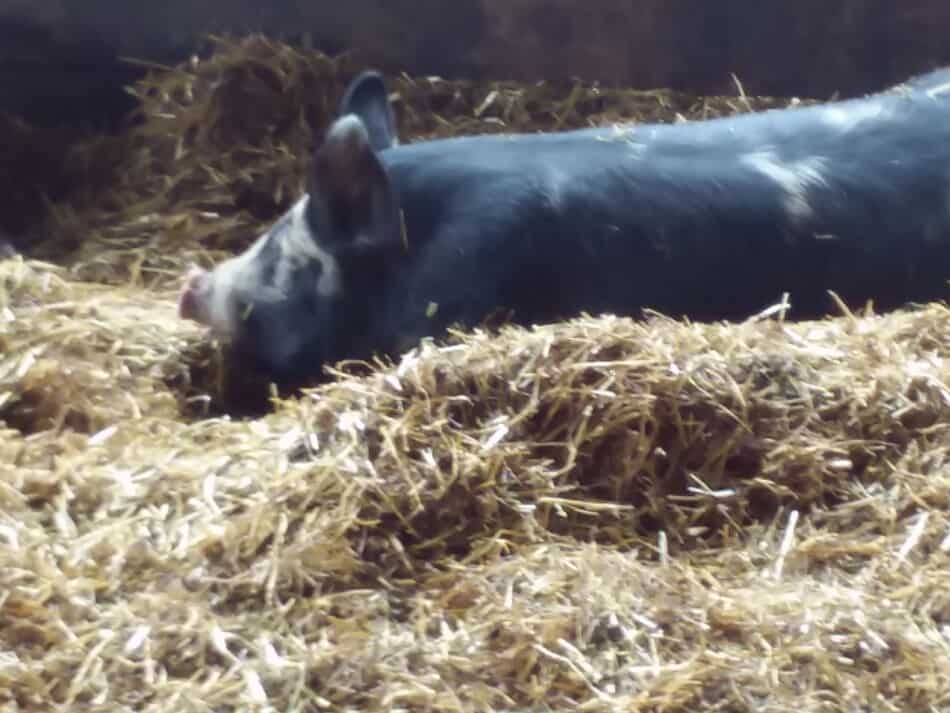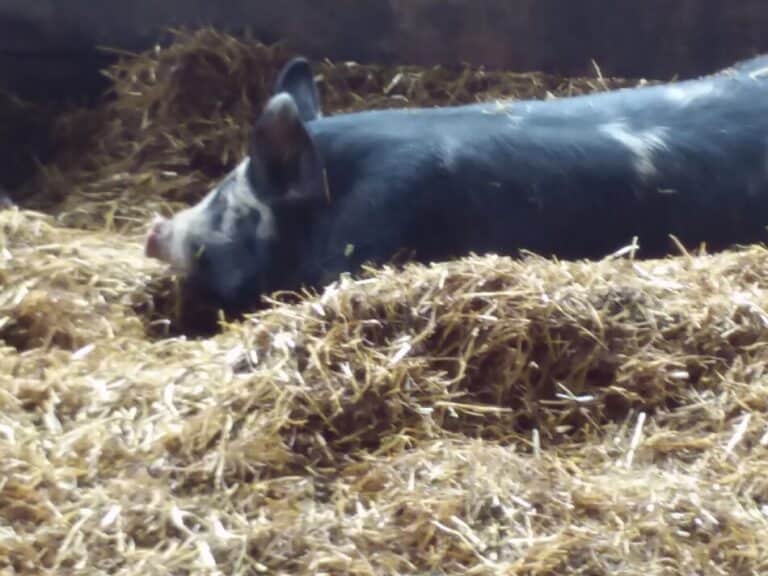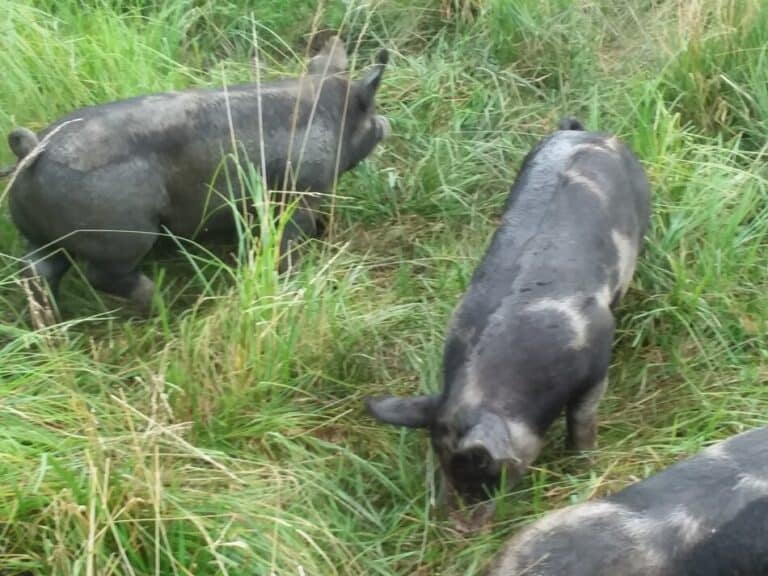The Best Pig Breed For Beginners Raising Their Own Pork

Thinking about raising your own pork this year? Getting a few feeder pigs is an exciting step towards taking control of how your food was raised and knowing what you are feeding your family!
As you look around for advice on how to get started, you’ll see plenty of advice regarding one breed of feeder pigs or another. Which pig breed will work the best for you and why?
The best breed of pig for beginners is a crossbred. Crossbred pigs will have the added advantage of hybrid vigor and are more likely be hardy and easy to raise.
| Feeder pig trait | Crossbred pigs | Purebred pigs |
| Hardiness | high | variable |
| Price | moderate | moderate to high |
| Availability | available | harder to find |
| Hybrid vigor | yes | no |
| Locally adapted | likely | unlikely |
Is Raising Pigs For Meat Worth It? is an article that I wrote that will walk you through a budget for raising and processing your own pork.
The best breed of feeder pig to get is a crossbred
The best breed of feeder pig for you to get is a crossbred pig. A crossbred or hybrid pig has purebred parents of different breeds that are bred together to produce a piglet that has the best growth traits of both parents.
A very popular crossbred feeder pig in our area (Ohio) is a Blue Butt, which is a cross of a white sow (Yorkshire, Landrace, Chester White) and a colored boar (Berkshire, Duroc, Hampshire).
Your local area will have a favored cross. What exactly the specific cross is does not matter, as long as the parent pigs are all full size hogs.
You don’t want any small pig breed genetics in your meat pigs, they’ll be slow growers.
As long as you like the looks and attitude of this local crossbred pig, go with whatever the experienced pig raisers in your area are using.
Get your feeder pigs from a small farmer or small pig raiser
It’s important to get your feeder pigs from a small farmer that is hands on with the pigs. You want to get pigs from a person raising pigs the way you plan to raise yours or as close to it as you can find.
Purebred pigs can be good feeder pigs
Purebred piglets would have a mom (sow) and dad (boar) of the same breed. This is the type of pig you are looking for if you want to raise breeding stock.
Purebred pigs have the characteristics of the breed, so you know what you are getting and the genetics will reliably reproduce themselves.
Meaning a Duroc sow and a Duroc boar bred together will have piglets that will grow and perform like a Duroc. Only purebred pigs will give you this level of reliability in results for generation after generation.
If the feeder pigs that you are coming up with for your area are purebred piglets, that’s fine as long as they are meat genetics from a common breed of pig like Yorkshire, Duroc, Hampshire, etc.
There are great pigs available from many breeds, just make sure that the feeder pigs you are getting are being selected by the breeder for growth and meat characteristics.
Choosing The Best Pigs For Breeding Stock gives you tips for picking out the breeding stock for your pig operation.
The downside of purebred piglets are price and likely slower growth
First off, feeder pigs that are purebred are likely to cost more money than a crossbred. This is because they are worth more, since the purebred piglets have the potential use as breeding stock.
The other potential downside of purebred feeder pigs is that you do not get the advantage of hybrid vigor. Hybrid vigor is the increased growth in a crossbred when compared to a purebred of the same age.
This is the reason why most of the feeder pigs you see are crossbreds, they just grow better and seem to be more hardy.
Getting feeder pigs from great breeders is the key. High quality purebred pigs will grow just as well as a nice crossbred. Low quality purebred pigs will not. Be sure you know which you are paying for.
Do not choose a rare or unusual breed of pig for your first feeder pigs
Pigs from rare or unusual breeds are not going to be your best choice as a beginner. The rare and unusual breeds are rare for a reason, normally it’s because they are slow growers.
There is nothing wrong with rare or unusual breeds of pigs! They are just more needy management wise in order to get the results you want, so it will be less likely that you will be happy with the results!
As mentioned above, normally the “thing” with rare breeds is that they are slow growers, compared to a more common pig breed.
This means more time to get your pigs to finishing weight and more cost in feed for you.
Be especially cautious of small breed pigs. These pigs will take a long time to gain weight and will not give you much pork for your money and time.
Have a butchering appointment set before you get pigs
Be sure to get a butchering appointment before you get your pigs! The last few years have been crazy as far as getting slaughter appointments for meat animals.
Call early to make sure your pigs can be fit into the local butcher’s schedule.
Make the processing appointment for when the pig is 6-8 months old
The exact time that you need your processing appointments for will depend upon the genetics of your pigs and how you raise those pigs.
The breeder that you get your pigs from should know how these genetics are likely to grow.
Ask the breeder when you should schedule your appointment and make sure your pigs are on the books before you buy them.
Generally speaking, meaning let’s figure you bought a few crossbred feeder pigs and are raising them will all of the feed they can eat, they will be butcher ready at about 6 months of age.
If you like a bigger hog, more like 300+ pounds, give yourself more time to get those pigs to weight. For a 300+ pounder, make the appointment at more like 6.5-7 months of age.
If you are raising your pigs on pasture, raising a unusual pig or are giving them little grain, you’ll need longer, 8+months.
What you feed the pigs, how you feed them (unlimited feed or limit feeding) and how you manage their care will affect the rate at which they will gain, which will determine how long it takes for you to raise your pigs to butchering size.
You can butcher your pigs at home
You can also butcher your pigs at home. If you are a deer hunter, you should have no problem making this happen as long as you get ahold of a tractor with a loader to lift the pig.
If you have no butchering or hunting experience, home butchering will be tough. Get someone who knows what’s going on to help you.
Get your pigs as 50 pound feeder pigs
After you have your appointment set up, it’s time to go pick up your piglets!
You are looking for 50-60 pounders that have shiny hair, spunky attitudes, are wide between the front legs and are on the bigger end of their litter.
Also, if you have a choice, barrows (castrated male piglets) will grow faster than gilts (female piglets), so choose the barrows.
Some areas of the country tend to sell smaller feeder pigs than 50 pounds, closer to 34 pounds and 8 weeks old. Nothing wrong with that if this is a normal age for your area.
I would prefer a bigger feeder pig, since a piglet that is older is a bit more hardy and will have completely transitioned to eating feed only, no more relying on part of his diet from mom’s milk.
An older feeder pig also tends to handle the stress of moving better than a young one.
Never buy small or unthrifty feeder pigs!
Whatever you do, do not buy the runt! It will take forever to reach butchering weight. By forever, I mean half again as much time and feed.
No joke, I did the math on a batch of pigs I fed out last summer. The runt, who I called “Squiffy” was perpetually behind her peers in growth and took a month and a half longer than her growthier siblings.
Do not buy unthrifty pigs. These are pigs that seem dull acting, look like the have a big head in proportion to their body or have long hair. At best, these pigs are slow growers.
Save yourself time, money and frustration, start off with great feeder pigs to get great results!
A few years ago I bought 4 little Hampshire feeder pigs, emphasis on little! Wow were they small. But they were healthy and in my price range so I got them.
While they did well for us and did finish out as nice pigs, they seemed to take forever to get to market size.
Color of the pigs does not matter as long as you like the parents
Do not worry too much about the color of the piglets. As long as you like the parents of the litter, whichever color the piglets end up being doesn’t matter since in the same litter all the piglets have the same genetics.
The structure (width) and size (weight, being big compared to siblings) does matter, but color within the same litter does not.
I have a Blue Butt sow, Whitney, that always has a few white pigs in her litters, even though the boar is black.
The white piglets and the black piglets all are the same genetics, the only difference is skin coloration. The white piglets and the black piglets will all have the same potential to grow well when fed properly.
Homegrown pork flavor is determined by feed and fat
The main determinant of the flavor of your pork will be from the pig’s diet and the amount of fat (marbling) that is in the meat. Breed is only a small part of how your pork will taste.
The breed and, more accurately, the specific genetics of your feeder pigs will determine how quickly they grow, how easy they are to get along with and what their body structure is, but taste is all about feed.
Here is a very interesting paper from Iowa State University on the differences between crossbred and purebred pigs. The paper is from 1957, but don’t let that throw you, the basic ideas are still the same!





